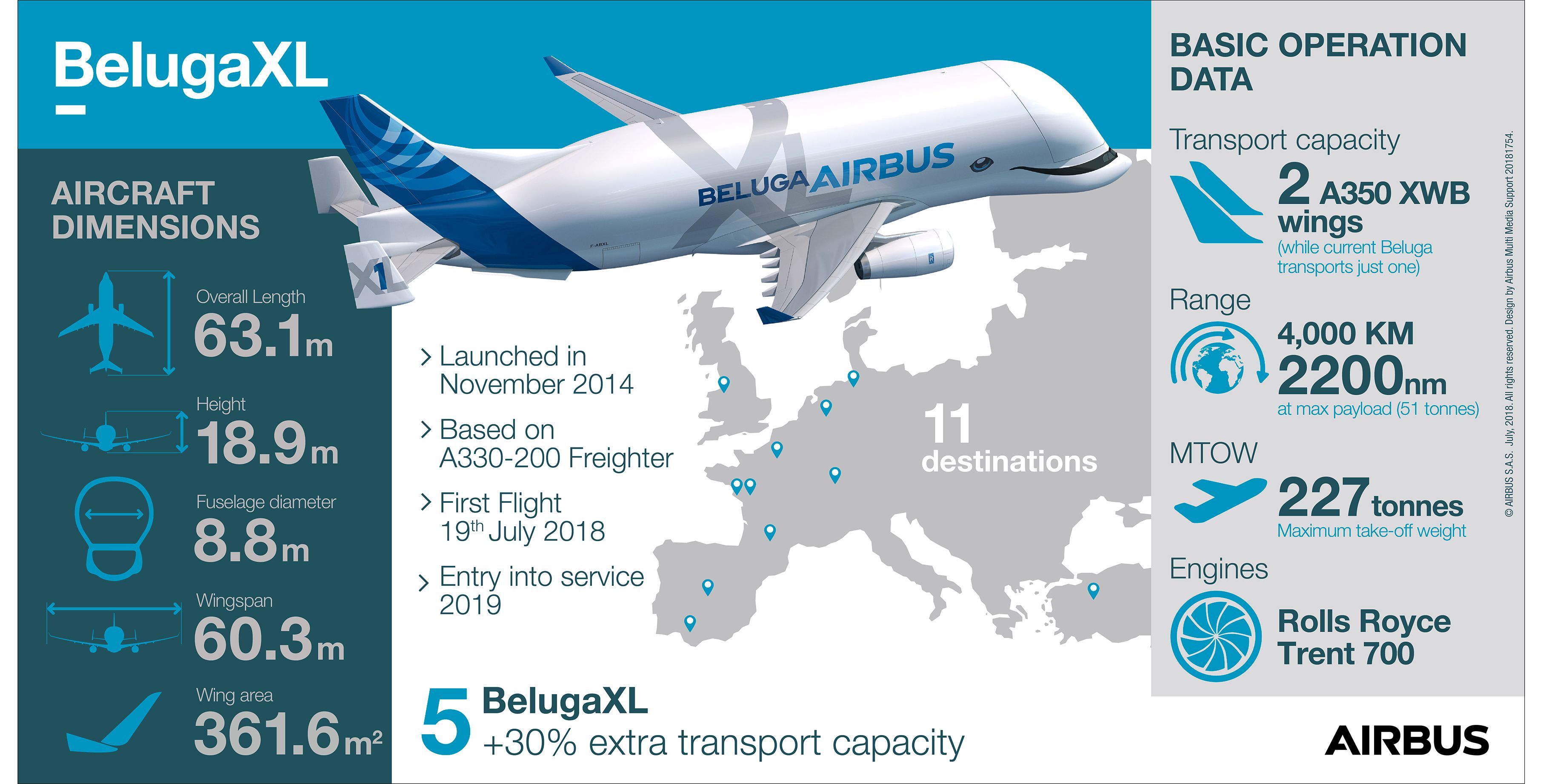Aviation
10 things about Beluga Cargo Aircraft

1. How beluga linked with A300 and A330
10 things about Beluga Cargo Aircraft : The Airbus A300-600ST (Super Transporter) or Beluga, is a version of the standard A300-600 wide-body airliner modified to carry aircraft parts and oversized cargo.The Beluga XL, based on the Airbus A330 with similar modifications and dimensions, is being developed by Airbus to replace the type around 2020.

Beluga no 1
2. The Name Beluga:
It received the official name of Super Transporter early on, however changed the name Beluga, a whale it resembles
3. Beluga completed 24 years.
The first beluga was taken maiden flight on 13th September 1995 and It derived from Airbus A300 version
- 1994 first beluga tested
- Oct 1996 first entry No 1
- April 1996 No 2
- May 1997 No 3
- July 1998 No 4
- Jan 2001 No 5
Since 1994- 2018 Beluga completed 24 years of outsized cargo transport with the Airbus
4. New Beluga XL has smiling livery
This initial BelugaXL is expected to be flying by mid-2018. “The whole team is really looking forward to seeing its first flight and, of course, it’s smiling livery,” said George, referring to the supersized smile that will be painted across the ‘face’ of the transporter, the winning design of six options presented to Airbus employees for a vote in early 2017.

Beluga XL smiling livery
5. The Beluga XL
Beluga XL will be able to carry larger sections of Airbus aircraft between European production sites and to the final assembly lines in Toulouse, France and Hamburg, Germany – including a full wing-set for the A350 XWB’s latest A350-1000 version. It ranges around 4000km. MTOW (maximum take of weight) is 227Tonns

10 things about Beluga Cargo Aircraft
10 things about Beluga Cargo Aircraft
6. The beluga Size:
Main deck cargo volume of the Beluga is greater than that of the C-5 Galaxy or the Antonov An-124
but still smaller than Antonov An-225. Enlarged fuselage “bubble” section that is six metres longer and one metre wider than on the Beluga ST
Read about : First BelugaXL transporter rolls out
7. Difference between Beluga ST and XL
Among the physical differences between the Beluga ST and XL versions is the dorsal fin that connects to the vertical tail plane. St is derived from A300 fuselage and XL is from A330. At six metres longer, one metre wider and with a payload lifting capacity six tonnes greater than the BelugaST transporter version it is replacing
Height
Beluga: 17.24m
Beluga XL: 18.9m
Wing span
Beluga: 44.84
Beluga XL: 60.3m
Length
Beluga: 56.15m
Beluga XL: 63.1m

10 things about Beluga Cargo Aircraft
8. Where it flies
It carries the parts from different Production Sites around Europe to the final assembly
Lines in Toulouse, France and Hamburg, Germany. [read more about beluga (Airbus )]
9. Unit Price:
Current Beluga ST Unit price is around $285 million and Airbus built only 5 aircraft models since from 1994. And Beluga XL would cost more than $335 million. The company has not yet disclosed any price list.
10. Beluga XL replaces Beluga ST.
The initial BelugaXL is expected to be flying by mid-2018 after a sequence of jet engine tests and a paint job. With the first plane rolled out of the way, a second conversion will now begin at the hangar in Toulouse. The Beluga fleet will rise to eight when three XLs will be delivered as the five originals stay in service before being withdrawn from 2021.

Aviation
Boeing, Antonov to Collaborate on Defense Projects

– MOU represents Boeing’s commitment to work with Ukrainian industry
– Includes exploring opportunities for collaborating on in-country support of Unmanned Aerial Systems
A Memorandum of Understanding was signed today by Boeing and Antonov Company to investigate potential collaboration on defense-related projects.
“We’re happy to keep collaborating with the Antonov Company to help Ukraine’s economic development and expansion,” stated Ted Colbert, CEO and president of Boeing Defence, Space, & Security.
Airbus and the Antonov An-225: The Best Partnership:Click here
“This agreement demonstrates our ongoing efforts to find more opportunities to work with Ukrainian industry, which was underscored by our signing of the Ukrainian Defence Industry Compact earlier this year.”
The areas of potential collaboration identified in the agreement consist of training, logistical support and overhaul services for tactical Unmanned Aerial Systems utilized by the Ukrainian Armed Forces, which includes the ScanEagle. In addition, the companies will also explore opportunities for Antonov to provide engineering support to Boeing.
The six largest cargo aircraft ever built in the aviation industry:Click here
“A strong, innovative, and efficient defense industry is key to sustainable economic development and national security, and we are extremely excited to collaborate with Boeing,” said Ievhen Gavrylov, CEO of Antonov Company.
This agreement brings a whole new level of opportunity to implement the latest and most effective solutions – in addition to the possibility of future projects with Boeing in the aerospace and defense industry.”
-

 Travel1 week ago
Travel1 week agoAir India to Expand US Operations with Three New Routes After a Decade
-

 Travel2 weeks ago
Travel2 weeks agoWhy We Should Avoid These Stamps in a Passport
-

 Airlines1 month ago
Airlines1 month agoInvestigations Reveal Fake Chinese Titanium in Boeing and Airbus Jets
-

 Tech4 weeks ago
Tech4 weeks agoChina’s CATL Plans 1,800-Mile Electric Plane Launch by 2027
-

 Airport3 days ago
Airport3 days agoTop 10 Largest Airports in the World by Size
-

 Aerospace4 weeks ago
Aerospace4 weeks agoChina’s Fighter Jets Turn Wings into Autonomous Drones
-

 Airlines4 days ago
Airlines4 days agoAir India Rolls Out A350s for Delhi-New York JFK and Newark Routes
-

 Defence3 weeks ago
Defence3 weeks agoBoeing Enhances Chinook with New Engines and Block II Upgrades at $96 Million







